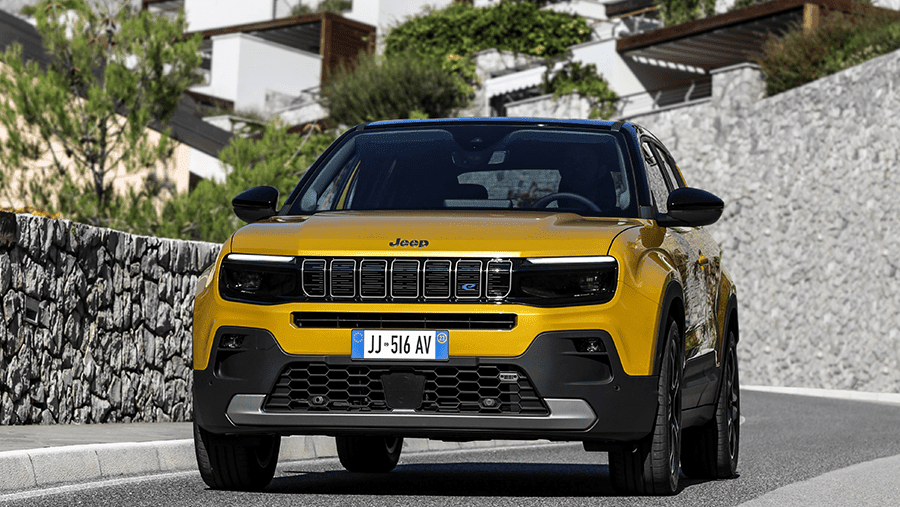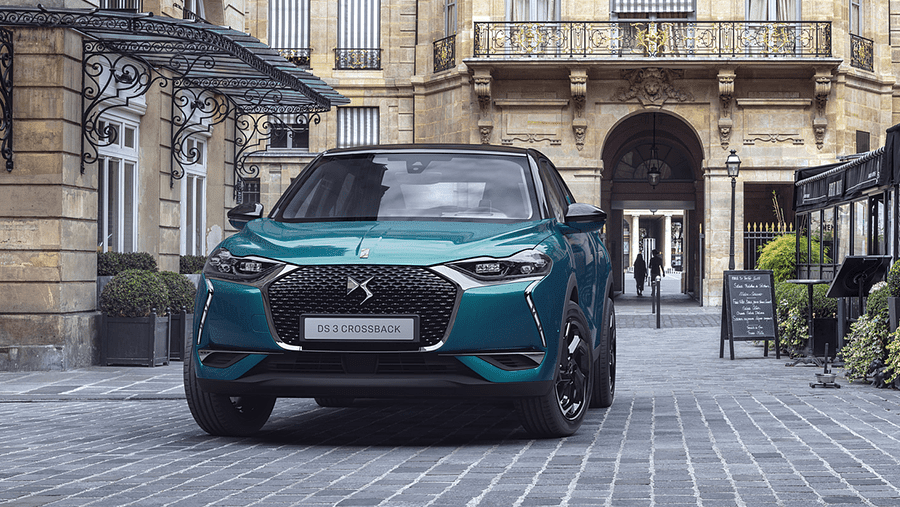
Jeep Avenger Review (2023)

Introduction
Jeep is possibly the most American of car brands. It’s well known for its big, brash SUVs with meaty petrol engines and admirable off-road abilities. But in recent years, it’s also had a European alter-ego, producing compact and on-road-focused models like the Renegade and Compass.
Now, it’s taken another step away from its traditional image, dipping its tyres into the world of electric vehicles. While other Jeep models get petrol/electric hybrid updates this year, the Avenger is a pure electric model straight out of the box, designed and built in Europe to suit European roads and drivers.
Select's rating score* - 4.0 / 5
At a Glance
Jeep describes the Avenger as a “compact” B-SUV rather than a “long” one. That’s largely to differentiate it from the larger Renegade, which also sits in the small SUV segment.
At 4.08m by 1.78m, it’s definitely among the smallest cars in the class, but Jeep has been smart with its packaging to get the most out of the Avenger.
Externally, the Avenger looks like a car designed by Europeans for Europeans rather than an import from the other side of the Atlantic. It’s a well-proportioned, chunky machine with short overhangs and just the right amount of cladding.

The slightly cartoonish proportions, with clearly pronounced wheel arches, a broad dark grille and slimline lights, hint at the brand’s rugged legacy without trying too hard or coming over as too aggressive — key in a segment where bold but friendly looks win over.
Speaking of bold, the Avenger looks brilliant in the Sun Yellow launch colour, and there are other equally eye-catching shades, including Lake Blue and Ruby Red, as well as more conservative hues if you don’t want to stand out.

Key Features
Jeep is keen to claim that nothing about the Avenger’s design is purely aesthetic, and the car has been engineered to channel at least some of Jeep’s traditional strengths.
Hence, the short overhangs, which give it the best approach and departure angles in the segment, and class-leading ground clearance. In fact, the Avenger’s 200mm of clearance is a match for the standard ride height of the massive Grand Cherokee.
The body cladding, too, is apparently designed to take the pain out of bumps and scrapes — although these are more likely to be picked up in a supermarket car park than out on the trails. Jeep reckons the easily replaceable plastic trim could save owners up to £1,000 in paintwork repairs over the car’s life.

Jeep is, of course, famous for its 4x4 models, yet the Avenger is resolutely a front-wheel-drive machine, although a four-wheel-drive ‘4Xe’ hybrid version is on the way. To go some way to maintaining the brand’s rugged image, the Avenger is the first front-wheel drive Jeep to come with the Selec-Terrain traction management system, offering sand, snow and mud modes to cope with slippery terrain, plus hill descent control usually reserved for four-wheel-drive.
None of this is enough to send you scampering up a mountainside, but it does render the Avenger marginally more capable than you might expect.

Performance & Drive
When it comes to the powertrain, Jeep is keeping things simple with a single battery and motor combination and is among the first models in the Stellantis family (it owns Citroen, Peugeot and Vauxhall, amongst others) to get the group’s upgrade setup.
The 54kWh battery offers up to 248 miles of range in mixed-use, while 100kW charging allows for a 20-80% charge in 24 minutes — a significant improvement over the old 50kWh pack in previous Stellantis cars. To get the most out of each charge, be sure to check out our guide to picking your ideal electric car charger.
The front-mounted motor puts out 156hp and 260Nm, good enough to get the Avenger from 0-62mph in 9.3 seconds and on to a limited top speed of 93mph. That’s hardly the scintillating performance offered by some EVs, but in the general cut and thrust of everyday motoring, there’s enough instant torque to make decent progress.

Eco and Normal modes both damp the throttle response and limit power output to a paltry 81hp in Eco mode and 108hp in Normal, although a heavy shove of the throttle can override this. Or you can opt for sport mode, which gives you all 156hp all the time and adds some artificial extra weight to the steering.
That adds little to the overall driving experience, and the Avenger is very much a car for making easy progress rather than driving around like your hair’s on fire. There’s impressive body control that keeps things level on twistier roads, but the Avenger’s real strength lies in its smooth, composed ride, which is impressive for a car in its segment.
That was ably demonstrated on a rocky, unfinished trial along our test route where the suspension soaked up even severe lumps and bumps, and the sand mode marshalled the torque well.
Pleasingly, the Avenger is as quiet as it is smooth and even at motorway speeds, wind and tyre noise aren’t overly intrusive.

Running Costs
Jeep says the Avenger is “electric made inclusive”, although with a cash price of £35,700 and leasing rates starting at around £440, some people’s ideas of inclusive may differ. It still undercuts the equivalent DS3 Crossback E-Tense but lacks that car’s more luxurious finish.
Official figures put the Avenger’s range at 248 miles and energy consumption at an impressive 4.0 miles/kWh. Pleasingly, our test drives over a mixture of motorway, mountain, and urban driving showed very close to that in real-world usage. You can find out more about how official range converts to real driving in our guide.
Jeep offers a standard three-year warranty on the Avenger, which is pretty miserly compared with some other manufacturers, but the battery is protected for eight years or 100,000 miles.

Interior
Although its exterior footprint is smaller than several petrol-powered rivals, such as the Ford Puma, Nissan Juke and Renault Captur, the Avenger offers impressive interior room. It’s perhaps not “incredible” like Jeep claims, but it’s certainly surprisingly spacious for four, as long as the driver doesn’t have their seat all the way back.
The boot is big enough to hold 2,443 rubber ducks — it’s a Jeep thing, apparently — and the interior nooks and crannies will accommodate more than 500 ping-pong balls. For the more traditionally minded, that’s a 355-litre boot and enough space in door pockets and the centre console for phones, sunglasses, iPads and more.
That centre console features a neat folding cover to a deep storage bin and the optional wireless phone charger, plus a couple of capacious cupholders. Above that are drive select buttons and a simple and welcome line-up of physical switches for the automatic climate control.

Most other functions are controlled via the standard 10.25-inch touchscreen that sits proud of the dash and thankfully dispels memories of previous Jeep infotainment systems with its sharp and responsive interface.
Beneath the screen, a horizontal beam runs the width of the car to echo other Jeep models and enhance the feeling of width. Take our advice and choose a version that comes with the body-coloured dashboard — it really helps lift the otherwise somewhat drab colour scheme and hide the fact that there are one or two questionable bits of trim lurking beneath the overall fairly solid finish and standard Stellantis switchgear.

Safety
The Avenger hasn’t been tested by Euro NCAP yet but does come with a familiar suite of safety tech, including autonomous emergency braking with pedestrian and cyclist detection, traffic sign recognition and lane keep assist. Top-spec Summit adds adaptive cruise control and active lane centring, blind spot monitoring and auto dipping headlights.

Options
Prices for entry-level Longitude models start at £35,700, with Altitude (£37,400) and Summit (£39,600) above it. Leasing prices for the Jeep Avenger begin at £442 per month* with Select Car Leasing.
All versions get alloy wheels (16 to 18 inches), parking sensors, a connected 10.25-inch main screen, autonomous emergency braking with pedestrian/cyclist detection, traffic sign recognition, and lane keep assist.
Altitude upgrades the seven-inch digital instruments to a 10.25 display and brings nicer seat fabric and a hands-free powered tailgate. On top of that, Summit offers highway assist driving modes, a surround-view camera, LED lights and multi-coloured ambient lighting.

Beyond this, there are still plenty of options to pile more kit onto your Avenger. Paint, including metallic and two-tone finishes, ranges from £700 to £1,100, while different wheel options are available as £250 add-ons or part of larger packs.
On lower grade cars, the £1,400 Tech and Style pack bundles together kit including 17-inch alloys, faux leather steering wheel, auto headlights and adaptive cruise control.
The £1,000 Infotainment and Convenience pack offers traffic sign information, keyless entry, the 10.0-inch digital instruments, a larger central screen and wireless phone charging.
A £350 winter pack brings heated seats, wiper de-icer and velour carpets, while Altitude can be upgraded with the £1,100 ADAS pack, which brings the Summit’s level 2 automated systems.
There are also a host of personalisation options, including stickers for the grille inserts, roof and bonnet decals in several patterns, colour mirror caps, aluminium door steps and a special electric blue finish to the alloys.

Rival Cars
If the car’s size is more important than its powertrain, there are the usual B-SUV suspects to consider against the Avenger. The Ford Puma, Nissan Juke, Volkswagen T-Roc and Kia Stonic all offer similar space and tech and fractionally more space for less money, thanks to the presence of cheaper petrol engines.
In the all-electric stakes, the Avenger is up against the DS 3 Crossback E-Tense, which is based on the same platform and uses the same powertrain. However, that’s positioned as a slightly more premium option, and prices reflect that, starting at just over £37,000.

Also based on the same underpinnings and also slightly more expensive are the Vauxhall Mokka-e and Peugeot e-2008, both of which have already received or are due to receive the powertrain upgrade and neither of which has quite the ruggedness of the Avenger.
Away from the Stellantis group, the Avenger’s price puts it up against the Kia Soul EV and its larger stablemate, the Niro. The Soul has a cheaper Urban model with a smaller 34kWh battery, and the 64kWh Explore version comes in at £39,000, while the larger and more modern Niro starts at £37,295. Both of these offer long kit lists and seven-year warranties as standard.

Verdict
There’s no doubt the Avenger is a genuinely new breed of Jeep, but it’s one that bodes well for the brand’s future in Europe.
It has a style and charm that will pull prospective buyers in, especially given its slightly leftfield positioning and the host of personalisation options.
But there’s plenty beneath the surface to win over buyers from other segments and brands. Clever packaging means it offers impressive space and practicality for its tiny footprint and the powertrain, while hardly fire-breathing has a usable balance of performance and impressive efficiency. Combined with a smooth ride and smart bundle of technology, it’s a promising first step on Jeep’s electric journey.
Where to next?
View our latest BMW Avenger lease deals, from £442.39 per month**.
Call us on 0118 3048 688 or hit the green 'Enquire' button for more details.
Looking for a great leasing deal? Check out our incredible range of car lease deals
New SUV? Read our latest Car Reviews and find the right model for you
Want to know more about leasing? Take a look at our comprehensive Leasing Guides
Interested in everything motoring? Why not catch up on all the latest Car Leasing News.
*Score based on Select’s unique meta score analysis, taking into account the UK’s top five leading independent car website reviews of the Jeep Avenger
**Prices include VAT. Credit is Subject to Status, Ts and Cs and Arrangement Fees apply. Excess mileage may apply. Stock levels and prices correct as of 22/05/23.




















